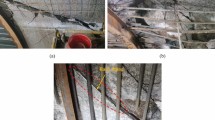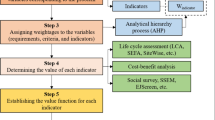Abstract
Tunneling projects are generally complex projects with numerous affective factors, including variable and unreliable conditions of the land. One of the appropriate tools for conducting a successful project is the implementation of risk management during its lifetime. The clustering of tunneling risks is an effective part of risk management. The research aims to achieve an optimization risk assessment based on clustering techniques in the projects which are faced with deep drillings. Hence, in this study, with contribution of the field study and use of failure modes and effects analysis results, the seven geological sections in the path of the second part of Emamzade Hashem tunnel are considered. In these seven sections, the area of instability around the tunnel, groundwater inflows and squeezing are used in the risk assessment as analysis criteria. The clustering of risks is determined by meta-heuristic algorithms such as particle swarm optimization based on stochastic optimization technique and Fuzzy C-means clustering approach as optimization techniques. The Emamzade Hashem tunnel is located in the north of Iran. The present study in the second part of Emamzade Hashem tunnel on Haraz road, one of the longest road tunneling projects in Iran, shows that results are in full compliance with soft computing results. It was found that the performance of the intelligent modelings had significant capability to evaluate the geotechnical risks of tunneling. Finally, seven sections in the path of the second part of this tunneling project were classified into two categories of the highest level and the lowest level of risk.





Similar content being viewed by others
References
Abraham A, Guo H, Liu H (2006) Swarm intelligence: foundations, perspectives and applications. Springer, Berlin, pp 3–25
Aryafar A, Mikaeil R, Haghshenas SS, Haghshenas SS (2018) Application of metaheuristic algorithms to optimal clustering of sawing machine vibration. Measurement. https://doi.org/10.1016/j.measurement.2018.03.056
Aryafar A, Mikaeil R, Doulati Ardejani F, Shaffiee Haghshenas S, Jafarpour A (2019) Application of non-linear regression and soft computing techniques for modeling process of pollutant adsorption from industrial wastewaters. J Min Environ 10(2):327–337
Assareh E, Behrang MA, Assari MR, Ghanbarzadeh A (2010) Application of PSO (particle swarm optimization) and GA (genetic algorithm) techniques on demand estimation of oil in Iran. Energy 35(12):5223–5229
Babazadeh A, Poorzahedy H, Nikoosokhan S (2011) Application of particle swarm optimization to transportation network design problem. J King Saud Univ-Sci 23(3):293–300
Bai Q (2010) Analysis of particle swarm optimization algorithm. Comput Inf Sci 3(1):180
Bezdek JC (1981) Objective function clustering. In: Pattern recognition with fuzzy objective function algorithms. Springer, Boston, MA, pp 43–93
Bezdek JC, Ehrlich R, Full W (1984) FCM: the fuzzy c-means clustering algorithm. Comput Geosci 10(2–3):191–203
Clerc M, Kennedy J (2002) The particle swarm-explosion, stability, and convergence in a multidimensional complex space. IEEE Trans Evol Comput 6(1):58–73
Dormishi A, Ataei M, Kakaie RK, Mikaeil R, Haghshenas SS (2019) Performance evaluation of gang saw using hybrid ANFIS-DE and hybrid ANFIS-PSO algorithms. J Min Environ 10(2):543–557
Eskesen SD, Tengborg P, Kampmann J, Veicherts TH (2004) Guidelines for tunnelling risk management: international tunnelling association, working group No. 2. Tunn Undergr Space Technol 19(3):217–237
Farret R, Gombert P, Lahaie F, Cherkaoui A, Lafortune S, Roux P (2011) Design of fault trees as a practical method for risk analysis of CCS: application to the different life stages of deep aquifer storage, combining long-term and short-term issues. Energy Procedia 4:4193–4198
Fouladgar M, Chamzini A, Basiri M (2011) Risk evaluation of tunneling projects by fuzzy TOPSIS. In: International conference on management
Haghshenas SS, Haghshenas SS, Barmal M, Farzan N (2016) Utilization of soft computing for risk assessment of a tunneling project using geological units. Civ Eng J 2(7):358–364
Haghshenas SS, Ozcelik Y, Haghshenas SS, Mikaeil R, Moghadam PS (2017) Ranking and assessment of tunneling projects risks using fuzzy MCDM (Case study: Toyserkan doolayi tunnel). In: IMCET 2017: new trends in mining—proceedings of 25th international mining congress of Turkey. pp. 289–296
Haghshenas SS, Mikaeil R, Haghshenas SS, Naghadehi MZ, Moghadam PS (2017b) Fuzzy and classical MCDM techniques to rank the slope stabilization methods in a rock-fill reservoir dam. Civ Eng J 3(6):382–394
Hasanipanah M, Naderi R, Kashir J, Noorani SA, Qaleh AZA (2017) Prediction of blast-produced ground vibration using particle swarm optimization. Eng Comput 33(2):173–179
Heller S (2006) Managing industrial risk—having a tested and proven system to prevent and assess risk. J Hazard Mater 130:58–63
Holland JH (1975) Adaptation in natural and artificial systems. University of Michigan Press, Ann Arbor
Hyun KC, Min S, Choi H, Park J, Lee IM (2015) Risk analysis using fault-tree analysis (FTA) and analytic hierarchy process (AHP) applicable to shield TBM tunnels. Tunn Undergr Space Technol 49:121–129
Jalilvand P, Haghshenas Shaffiee S (2013) The study stability of Toyserkan Doolayi Tunnel using reinforce shotcrete and rock bolt under static condition. In: The 23rd international mining congress and exhibition of Turkey. pp 1299–1305
Jalilvand P, Haghshenas Shaffiee S, Haghshenas Shaffiee S, Javan MH (2014) Evaluation of dynamic resistance of the Toyserkan Doolayi Tunnel by rock bolt and reinforced shotcrete composite system. Tunn Undergr Constr. https://doi.org/10.1061/9780784413449.037
Kennedy J, Eberhart RC (1995) Particle swarm optimization. In: Proceedings of IEEE international conference on neural networks, 1942–1948. IEEE Press, New Jersey
Khandelwal M, Marto A, Fatemi SA, Ghoroqi M, Armaghani DJ, Singh TN, Tabrizi O (2017) Implementing an ANN model optimized by genetic algorithm for estimating cohesion of limestone samples. Eng Comput 34:1–11
Khanlari GR (2011) Princples of rock mechanics (in Persian). Bu-Ali Sina University Press, Hamadan. ISBN 978-600-128-031-3
Khoury GA (2005) EU tunnel safety update. T T Int 37(2):41–43
Koopialipoor M, Armaghani DJ, Haghighi M, Ghaleini EN (2017) A neuro-genetic predictive model to approximate overbreak induced by drilling and blasting operation in tunnels. Bull Eng Geol Environ 78:1–10
Koorepazan Dezfuli A (2008) Principles of fuzzy set theory and its applications in the modeling of water engineering problems, 2nd edn. Jahad Daneshgahi, Branch of Amirkabir Industrial, Tehran
Li SC, Zhou ZQ, Li LP, Xu ZH, Zhang QQ, Shi SS (2013) Risk assessment of water inrush in karst tunnels based on attribute synthetic evaluation system. Tunn Undergr Space Technol 38:50–58
Lindhe A, Rosén L, Norberg T, Bergstedt O (2009) Fault tree analysis for integrated and probabilistic risk analysis of drinking water systems. Water Res 43(6):1641–1653
Linkov I (2006) From comparative risk assessment to multi criteria decision analysis and adaptive management: recent developments and application. Environ Int 32:1072–1093
Lloyd SP (1982) Least squares quantization in PCM. IEEE Trans Inf Theory 28(2):129–137
Meloy A (2006) Arenal-type pyroclastic flows: a probabilistic event tree risk analysis. J Volcanol Geotherm Res 157:12–134
Mikaeil R, Shaffiee Haghshenas S, Ozcelik Y, Shaffiee Haghshenas S (2017) Development of intelligent systems to predict diamond wire saw performance. Soft Comput Civ Eng 1(2):52–69
Mikaeil R, Haghshenas SS, Haghshenas SS, Ataei M (2018) Performance prediction of circular saw machine using imperialist competitive algorithm and fuzzy clustering technique. Neural Comput Appl 29(6):283–292. https://doi.org/10.1007/s00521-016-2557-4
Mohamad ET, Faradonbeh RS, Armaghani DJ, Monjezi M, Majid MZA (2017) An optimized ANN model based on genetic algorithm for predicting ripping production. Neural Comput Appl 28(1):393–406
Nezarat H, Sereshki F, Ataei M (2015) Ranking of geological risks in mechanized tunneling by using fuzzy analytical hierarchy process (FAHP). Tunn Undergr Space Technol 50:358–364
Onwunalu JE, Durlofsky LJ (2010) Application of a particle swarm optimization algorithm for determining optimum well location and type. Comput Geosci 14(1):183–198
Rad MY, Haghshenas SS, Kanafi PR, Haghshenas SS (2012) Analysis of protection of body slope in the rockfill reservoir dams on the basis of fuzzy logic. In: IJCCI. pp 367–373
Rad MY, Haghshenas SS, Haghshenas SS (2014) Mechanostratigraphy of cretaceous rocks by fuzzy logic in East Arak, Iran. In: The 4th international workshop on computer science and engineering-summer, WCSE
Salemi A., Mikaeil R., Haghshenas, SS (2018) Integration of finite difference method and genetic algorithm to seismic analysis of circular shallow tunnels (Case study: Tabriz urban railway tunnels). KSCE J Civ Eng 22(5):1978–1990. https://doi.org/10.1007/s12205-017-2039-y
Sayadi A, Rajabzadeh A, Hosseinpor M, Hayati M (2009) Risk ranking in tunneling projects using TOPSIS method. In: 8th Iranian tunneling conference. Tehran
Storn R, Price K (1995) Differential evolution- a simple and efficient adaptive scheme for global optimization over continuous spaces. Technical report, International Computer Science Institute, Berkeley, CA
Storn R, Price K (1996) Minimizing the real functions of the ICEC’96 contest by differential evolution. In: Proceedings of IEEE international conference on evolutionary computation, 1996. IEEE, pp 842–844
Ünler A (2008) Improvement of energy demand forecasts using swarm intelligence: the case of Turkey with projections to 2025. Energy Policy 36(6):1937–1944
Vaurio JK (2010) Ideas and developments in importance measures and fault-tree techniques for reliability and risk analysis. Reliab Eng Syst Saf 95(2):99–107
Vílchez J, Espenjo V, Casal J (2011) Generic event trees and probabilities for the release of different types of hazardous materials. J Loss Prevent Process Ind 24:281–287
Vutukuri VS, Katsuyama K (1994) Introduction to rock mechanics. National Institute for Resources and Environment, Japan Industrial Publication and Consulting Inc., Tokyo
Wang T, Lee H (2008) Developing a fuzzy TOPSIS approach based on subjective weight and objective weight. Exp. Syst. Appl 36:8980–8985
Yu S, Zhu K, Zhang X (2012) Energy demand projection of China using a path-coefficient analysis and PSO–GA approach. Energy Convers Manag 53(1):142–153
Zadeh Lotfi A (1965) Fuzzy sets. Inf Control 8(3):338–353
Acknowledgements
We would like to express our deepest thanks to Professor Mahdi Ghaem for his excellent advice.
Author information
Authors and Affiliations
Corresponding author
Additional information
Publisher's Note
Springer Nature remains neutral with regard to jurisdictional claims in published maps and institutional affiliations.
Rights and permissions
About this article
Cite this article
Mikaeil, R., Shaffiee Haghshenas, S. & Sedaghati, Z. Geotechnical risk evaluation of tunneling projects using optimization techniques (case study: the second part of Emamzade Hashem tunnel). Nat Hazards 97, 1099–1113 (2019). https://doi.org/10.1007/s11069-019-03688-z
Received:
Accepted:
Published:
Issue Date:
DOI: https://doi.org/10.1007/s11069-019-03688-z




